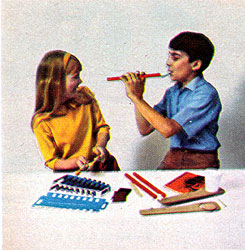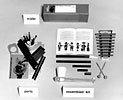Discovery of the Month Series
The ad for Discovery Kits in the 1969 catalog. |
The "Discovery of the Month" series was actually a "discovery every other month" series. For a purchase price of $15.00, a different kit was mailed to the purchaser every other month for a year. There was a kit on musical instruments, one on optical illusions, one on buildings and structures, one on telescopes and astronomy, one on color and light, and one on pendulums.
The criteria were simple: It had to cost no more than 65 cents to produce (in quantities of 1000), and it had to weigh no more than 13.5 ounces so it could be shipped by third-class mail. This total cost included the packing/assembling and the mailer. It was a fascinating set of criteria.
|
The full kit. |
In approaching the music kit, I quickly came to the conclusion that I wanted to show three kinds of instruments: those that are struck, those that are plucked, and those that are blown.
The idea of a "xylophone" came quickly, but the material posed another problem. Aluminum tubes were lighter but more expensive, while steel tubes were heavier but cheaper. All along the way, those involved in designing the series were constantly weighing their work. In one kit we went from a 70 pound paper for the booklet to a 50 pound paper-- just to save the weight.
The "xylophone" tubes rested in a folded card holder. The tubes were supported on insulation foam that allowed them to ring free.
The stringed instrument was stamped from a piece of luan plywood. A
hole stamped in the top was sized to accept a Styrofoam cup. The string
was a piece of nylon fishing line, held by a plastic tuning peg that had
a friction fit in a stamped hole. A bridge (a flattened dowel) supported
the string.
The wind instrument used a regular whistle mouthpiece into which fit an
extruded plastic tube. Three tubes were supplied. One could be used to
experiment with different lengths of tube to observe how the pitch was
effected. The second was used to form a "recorder," while the
third was a spare for further experimentation.
The finger holes in the recorder were made by puncturing the holes in the tube with a pin (following a pattern provided) and breaking out the center portion of the hole.
The "recorder" and the "xylophone" were tuned to each other, while the string instrument could easily be brought to the same pitch. In this way the three instruments could by played together.
|
The booklet for the Music Kit. |
The instruction book was copy-edited by an editor on staff, and illustrated by a professional illustrator.
An interesting problem involved the order of packing-- we had shipped several samples to California and back to see which packing arrangement prevented the steel tubes from going through the Styrofoam cup while being shipped.
My one failure was not finding a use for the cardboard shipper. I tried several ways of attempting to stretch a skin over the open end for a drum, but none were successful.
The "astronomy" kit, designed by Steven Caney, included parts
to make (from cardboard tubes) a reflecting telescope the equal to Galileo's--
and we DID see the moons of Jupiter with it!


